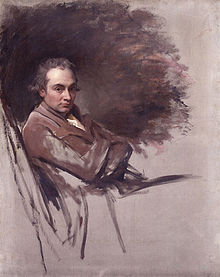George Romney (painter)
| George Romney | |
|---|---|

George Romney Self-portrait
|
|
| Born |
George Romney 26 December 1734 Dalton-in-Furness, Lancashire |
| Died | 15 November 1802 (aged 67) Kendal, Westmorland |
| Nationality | English |
| Known for | Painting |
George Romney (26 December 1734 – 15 November 1802) was an English portrait painter. He was the most fashionable artist of his day, painting many leading society figures – including his artistic muse, Emma Hamilton, mistress of Lord Nelson.
Romney was born in Beckside in Dalton-in-Furness, Lancashire (now part of Cumbria), the 3rd son (of 11 children) of John Romney, cabinet maker, and Anne Simpson. Raised in a cottage named High Cocken in modern-day Barrow-in-Furness, he was sent to school at nearby Dendron. He appears to have been an indifferent student and was withdrawn at the age of 11 and apprenticed to his father's business instead.
He proved to have a natural ability for drawing and making things from wood – including violins (which he played throughout his life). From the age of 15, he was taught art informally by a local watchmaker called John Williamson, but his studies began in earnest in 1755, when he went to Kendal, at the age of 21, for a 4-year apprenticeship with local artist Christopher Steele – a portraitist who had himself studied with distinguished French artist Carlo Vanloo. All costs were to be borne by George's father.
In October 1756, Romney married Mary Abbot (a decision he initially regretted), but the couple were immediately separated when he was called away to York on business by his employer. After a year, Steele eventually agreed to cancel the apprenticeship, at George's request, leaving the young artist – now a father of a son – free to pursue his own career as a painter.
In 1757, Romney rejoined his wife and young son in Kendal, working as a portraitist, landscape and historical painter. In this period he became friends with Adam Walker, the inventor and writer, and also pursued musical interests in his spare time. In March 1762, he parted from his wife, son and daughter (the latter dying in 1763), to seek his fortune in London, where he stayed (apart from a few return visits to Cumbria) until 1799. Throughout the separation, he maintained contact with his family and financially supported them, but they never lived with him in the capital.
...
Wikipedia
